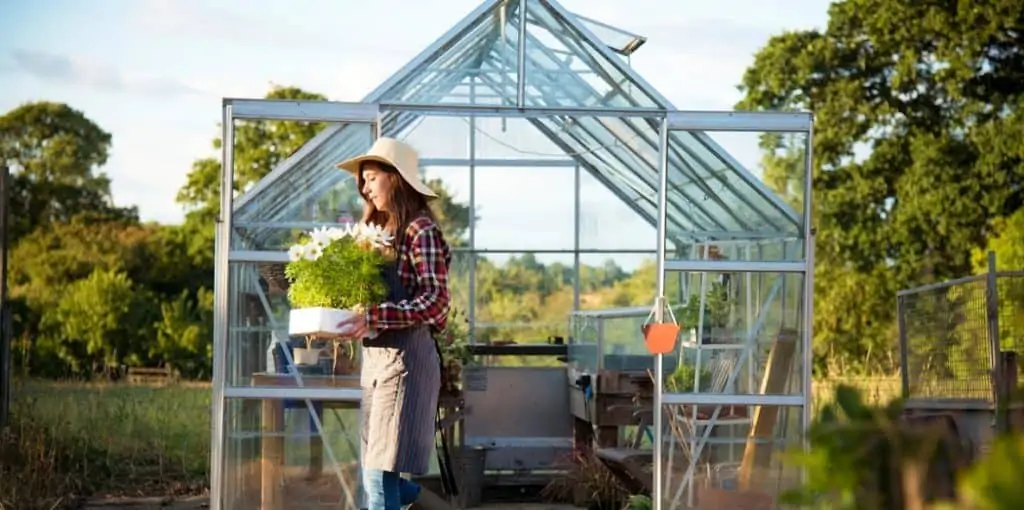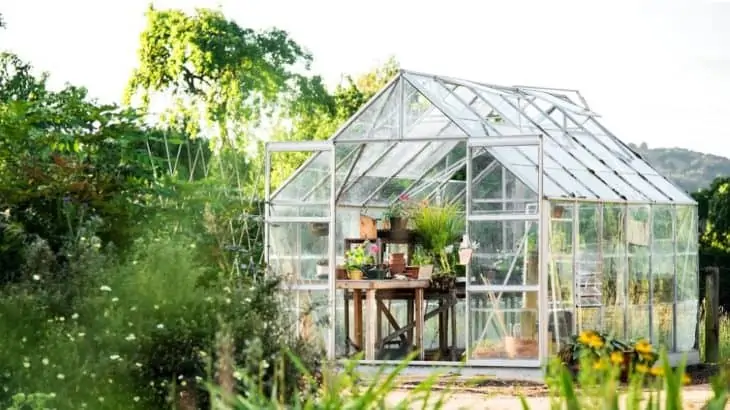In this article, we’re diving into the science behind an ever-popular growing environment – the greenhouse. We’ll explain why greenhouses are so effective, and how they use the “greenhouse effect” to hold their temperature so well. We’ll also dive into some tips & tricks for proper temperature control within the greenhouse itself.
Let’s start by explaining how a greenhouse works:
The Greenhouse Explained
A greenhouse is known for its ability to retain heat very effectively. You surely know of a greenhouse’s potential to create an ideal growing temperature for your plants. But you might not be aware of what actually occurs to make this happen. How does a greenhouse stay so much hotter than its surrounding environment? Let’s check out the science that makes it possible.
Step 1: Light from the Sun
The process all begins with light. Specifically, it begins with light that shines into the greenhouse from the sun. Of course, because every surface of a greenhouse is typically made from translucent materials, it lets a lot of light inside.
Step 2: Heat Energy
The light that enters the greenhouse is then turned into heat energy. This is done effectively because the items in the greenhouse (plants, soil, floors) absorb the light and convert it into heat energy. This is especially apparent in dark colored objects, which absorb more light, and retain heat even better.
Step 3: Heat Energy is Released
The dark objects that absorbed the light (plants, soil, etc.) and stored it as heat will then release the heat energy quite slowly. The objects cool as they release the heat energy into the air. Because this warm air is lighter than the cool air above it, it rises to the surface of the greenhouse.
Step 4: Nowhere to Go
The light entered the greenhouse as light energy, but it was released by the plant as heat energy (infrared energy). This heat energy actually has a different shaped wavelength than the light energy. This difference in shape actually allows the heat energy to become “trapped” by the exterior walls of the greenhouse once it rises the surface.
It entered the greenhouse as light energy, but has difficulty escaping the greenhouse as heat energy.
Step 5: Greenhouse Heats Up
With much of the heat effectively “trapped” in the greenhouse, the air within the greenhouse quickly warms up. The building’s temperature quickly rises during the day, as more light shines into the greenhouse.
In fact, on hot, sunny summer days, it can become too hot, requiring ventilation to keep from damaging the plants. Moderating the temperature inside a greenhouse is another undertaking in itself, and we’ll cover it in the next section.
And if you’re a visual learned, check out this neat explanation from NASA Kids (we know, it’s for kids, but it’s still a great explanation!):
The Greenhouse Effect
The above explanation was an example of the “greenhouse effect”. You have likely heard the term used to describe a similar effect which occurs in the Earth’s atmosphere. So now when you hear the term explained, you will have an understanding of what it means!
Controlling Temperatures in a Greenhouse
As you can see, a greenhouse’s interior temperature has the potential to get quite hot (or quite cold in the winter). Controlling this temperature is absolutely essential to the life of your plants. Depending on your climate, you will likely need to take measures to raise or lower the temperature inside your greenhouse at certain times of the year.
There are several methods for effectively controlling this temperature, and we’ll cover some of them here:
Thermometers
First thing’s first, you need to set up a method of “tracking” the temperature within your greenhouse. It’s difficult to moderate what you can’t even track. So, before you dive into our temperature control methods below, be sure that you actually have a method of monitoring what you attempt to control.
You can buy very detailed thermometers these days, and we recommend getting the best tools for the job. Some even include a hygrometer for measuring the water vapor in the air.
Heaters & Air Circulation
Depending where you live, you might experience extended periods of the year when it is too cold to effectively support life in your greenhouse. Even with the greenhouse effect working to raise the temperature in your greenhouse, you might simply not receive enough heat or sunlight to keep the greenhouse at an ideal temperature.
The solution to this problem is quite simple – heaters. Many rely on heaters to keep the temperature high during the winter months. There are many options for greenhouse heating on the market, and some are quite effective at generating a large amount of heat. Some heaters even make use of a fan to circulate the heat for you.
While we’re on that topic, be sure that your heaters are used in combination with effective air circulation. Purchase an air circulator, or a network of fans. Keep the hot air flowing throughout your greenhouse, so that you don’t have “hot” or “cold” spots throughout the environment.
Of course, there’s one other effective solution to getting your greenhouse through the winter months – not using it! Some choose to only use a greenhouse in the summer months. It’s really up to you.

Bubble Wrap
Another way to keep a greenhouse from losing heat in the winter is to better insulate the walls. But you want to do this in a way that won’t minimize the greenhouse effect. Bubble wrap is a great solution.
Bubble wrap still allows light to enter the greenhouse, which can be converted into heat energy. However, it provides an extra layer against heat escape. In effect, it amplifies the greenhouse effect.
Coating the walls in bubble wrap is a great way to up heat retention in the winter. It can be used in combination with your heating system to save you money on the power bill.
Location
Choosing the proper location for your greenhouse is one of the most important influences you can have over its temperature.
For maximum sunlight, it is best to have a greenhouse unobstructed to the South. Of course, maximum sunlight isn’t always your goal, as it depends on the type of plants you are growing as well as your climate. For slightly less sunlight, you can have your greenhouse face East.
Some opt to put a greenhouse under leafy trees. This allows the greenhouse more shade in the summer to prevent from overheating, and allows unobstructed sun in the winter when the leaves fall off.
Of course, this all heavily depends on your climate, what you are growing, and many other factors. It’s just best to be aware of how these factors affect the greenhouse’s light, so that you may modify it to suit your needs.
Ventilation
It should be obvious by now that greenhouses have the potential to get hot. Really hot. On hot summer days, they can get way too hot to support plant life. The typical solution to this problem is to ventilate the greenhouse, reducing the impact of the “greenhouse effect”.
Proper ventilation will almost always be necessary for proper greenhouse growing. Not only do you need windows and doors which allow heat to escape, but you need to a way to “blow” the air out of the greenhouse (fans, vents, etc.). Proper air circulation is necessary for this job.
Conclusion
Thanks for checking out our guide to the science behind the greenhouse. We aimed to not only explain the workings of a greenhouse, but to give you practical applications of this knowledge. By understanding the “greenhouse effect”, you can apply this knowledge to properly manage the interior temperature year-round. The result is happier, healthier plant growth!
